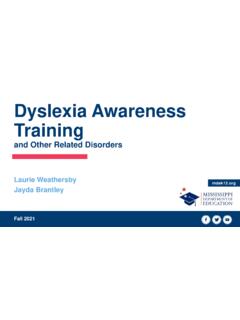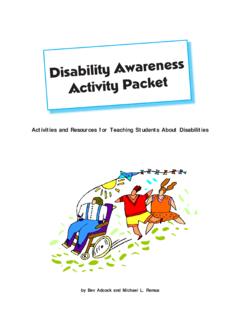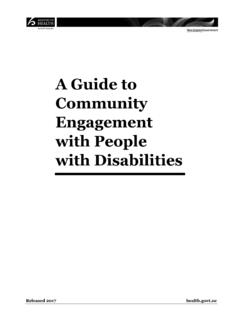Transcription of Increasing Cultural Awareness Through a Cultural Awareness ...
1 Journal of Educational Research and Practice 2015, Volume 5, Issue 1, Pages 1 20 Walden University, LLC, Minneapolis, MN DOI: Please address queries to: Beate Baltes, Walden University. Email: Increasing Cultural Awareness Through a Cultural Awareness Program Beate Baltes Walden University David Hernandez Walden University Christina Collins Walden University Racial tension motivates strife and violence in the metropolitan Detroit, Michigan, area. The purpose of this study was to determine the effectiveness of a collaborative partnership, the Cultural Awareness Consortium (CAC), in making a positive impact on the attitudes of a group of diverse high school students regarding multicultural relations. The two theoretical frameworks guiding this study were Allport s intergroup contact theory and intercultural competence theory originating from International Education and International Studies.
2 The research questions concerned whether attending the CAC for 4 months, the treatment, changed students attitudes on multicultural relations, and whether a student s gender or ethnicity was a predictor of changes in these attitudes. A single group, pre-experimental design with data collection from two administrations of the Student Multicultural Relations Survey was used in the study. Fifty-four students completed the survey, which yielded four multicultural relations scales (dependent variables), eight single-item attitudinal variables on multicultural issues, and two demographic variables (independent variables), and inferential analysis included t tests and multiple regression. According to study results, students attitudes on multicultural relations had changed significantly, and students talked to and mixed with students from different Cultural backgrounds more after the treatment.
3 Educational institutions providing experiences like the CAC can make a positive impact on students attitudes on multicultural relations. This can lead to positive social change as students increase their acceptance of others and take those attitudes and values with them into the workforce after they graduate, serving as role models of acceptance for their peers. Keywords: multiculturalism, racism, tolerance Introduction Racial tension motivates strife and violence in the metropolitan Detroit area. The Federal Bureau of Investigation (FBI, 2010) reported 6,628 crime victims who were different to their attacker in race, religion, sexual orientation, ethnicity/national origin, or disability. In Michigan, crimes related to race, ethnicity, and national origin rose 1%, from 219 incidents to 226 incidents, between 2009 and 2010 (FBI, 2009, 2010).
4 In public schools, the percentage of crimes motivated by Cultural and ethnic differences increased as students became older from 3% in third grade to 5% in 12th grade (United States Census Bureau, 2012). These statistics do not include noncrimes, such as the note containing Baltes, Hernandez, & Collins, 2015 Journal of Educational Research and Practice 2 racist language found at Seaholm High School in Birmingham, Michigan, that disparaged an African American student and three African American teachers (Maddox, 2012). Racial divisions exist among students, from elementary Through high school, and these divisions must be addressed Through Cultural Awareness training. One way to affirm Cultural differences in the classroom might be to establish collaboratives such as the intercultural collaboration of the Cultural Awareness Consortium (CAC), which provides high school students in Michigan opportunities to interact with students from various cultures.
5 Encouraging interactions with diverse people provides opportunities for personal and academic growth (DeLong et al., 2011). Allport (1958) reported that Cultural Awareness and interpersonal contact among diverse Cultural groups might serve to promote intergroup relationships and acceptance. Other researchers claimed that increases in Cultural Awareness might enhance students educational experiences (Carter & Vuong, 1997; Richardson, 2012). Therefore, this study investigated the relationship between high school students attitudes on multicultural relations and their participation in the CAC. The Cultural Awareness Consortium The CAC is located in an urban school district in Michigan. Students from six neighboring school districts are selected Through an application process, which requires counselor recommendation, referrals from teachers, a grade point average of or better, and an interview from the consortium board.
6 The CAC invites students to attend afternoon classes every day for 2 hr throughout the school year. During this time, students enroll in the advanced placement courses that are not available in their home high school. Students are integrated in these classes they sit together, work collaboratively on projects, and engage each other in reflective activities. The policies of the CAC are designed to foster a harmonious culture within the school, regardless of ethnic group or religion, and every student is expected to show respect to school staff and fellow students. Students who are disrespectful and cannot get along with others in the CAC may lose their privilege of attending this school. The CAC students interact with students of different Cultural backgrounds while being monitored by teachers to ensure a positive cross- Cultural collaborative experience.
7 The CAC provides a well-designed curriculum to deepen, explore, and engage students with daily interactions/discussions of political issues, social injustices, and Cultural views. The activities and discussions consisted of sharing Cultural history and personal interests. Discussions often occurred on (a) ancestry lineage, (b) movement of Cultural groups across geographic locations, and (c) the parallel and vertical alignment of ethnic commonalities, which are under the umbrella of culturally responsive pedagogy (Richards, Brown, & Forde, 2007, p. 64). Such discourse is thought to create a foundation for a higher level of understanding during students peer-to-peer interactions. During these classroom curricular interactions, students assignments of projects, activities, and collaborations required skills to recognize the similarities and differences in Cultural or environmental behaviors.
8 In an attempt to connect the diverse groups and increase Cultural Awareness , students may compare and contrast approaches to life, analyze and debate, as well as justify and explain them. Such interactions have more meaning than surface level interactions, and foster understanding of how people greet each other, what they talk about, and how they express themselves are characteristics of being culturally aware (Hansell, 2000; Quappe & Cantatore, 2005; Riskowski & Olbricht, 2010), which should lead to increased intercultural Awareness . To increase Cultural Awareness , Loukaitou-Sideris (2003) found that children must be given a common ground, or place to interact, play, talk, and collaborate across Cultural lines. In other words, Through intradistrict interactions, students will share their history, customs, and native language as they learn about each other.
9 Reich and Reich (2006) agreed that Cultural Awareness promoted within the same school could allow students to better understand the diverse country and world they Baltes, Hernandez, & Collins, 2015 Journal of Educational Research and Practice 3 inhabit. Furthermore, former University of Michigan President Lee Bollinger argued that students must be immersed in a campus culture that allows them to study with, argue with and become friends with students who may be different from them (as cited in Rothman, Lipset, & Nevitte, 2003, p. 25). Theoretical Framework Allport s (1958) intergroup contact theory and the theory of the intercultural competence, outlined by the International Education and International Studies organization, served as the two theoretical frameworks guiding the study. Intergroup Contact Theory Allport (1958) determined that interpersonal contact might be one of the most effective ways to reduce prejudice among diverse Cultural groups.
10 Allport maintained that in order for prejudice to be reduced, the collaborating members should have equal status, a common goal, and there should be no competition between the groups. Intergroup contact was defined as interactions between members of defined Cultural groups who meet face-to-face (Pettigrew & Tropp, 2006). The optimal conditions are an environment or situation in which students feel safe to speak and interact with others (Pettigrew & Tropp, 2006). Intergroup contact theory has been applied in the public school setting to decrease racial tension and minimize divisions between cultures by incorporating guidelines and support for students to work together in collaborative groups (Pettigrew & Tropp, 2006; Schuitema & Veugelers, 2011). As contact among diverse students increases, self- Awareness and opportunities to learn from others have also been shown to increase (Bazron, Osher, & Fleishmann, 2005; Pettigrew, 1998; Slavin & Cooper, 1999).















